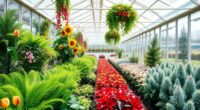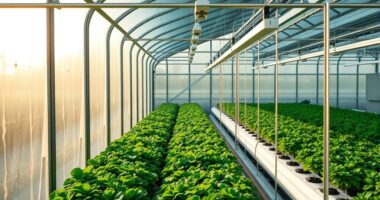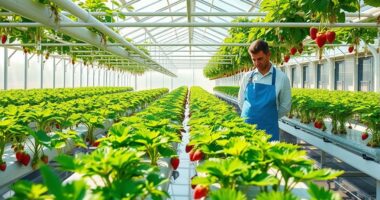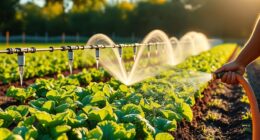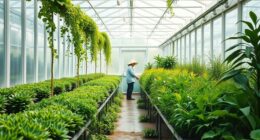Efficient irrigation systems like drip and aeroponics improve water use by delivering precise moisture directly to plants. Drip irrigation uses small emitters that slow water flow to roots, reducing waste and promoting healthy growth. Aeroponics suspends plants while misting roots with nutrient solutions, maximizing oxygen and minimizing water use. Both methods help conserve resources and boost crop health. If you want to explore how these systems can transform your farming practices, keep going for more details.
Key Takeaways
- Drip irrigation delivers water slowly directly to plant roots, minimizing waste and surface runoff.
- Aeroponics suspends plants in enclosed environments, misting roots with nutrient-rich water for precise control.
- Both systems optimize soil moisture management, promoting healthier crops and reducing water usage.
- Drip is ideal for soil-based cultivation, while aeroponics offers faster growth and disease reduction in controlled environments.
- Combining drip and aeroponics enhances resource efficiency, sustainability, and crop yields in modern agricultural practices.

Efficient irrigation systems are essential for maximizing water use and ensuring healthy crop growth. When you implement the right system, you can better manage soil moisture levels, which directly impacts plant health and yield. Maintaining ideal soil moisture means your crops receive the right amount of water, neither too much nor too little. This precision helps prevent issues like root rot caused by overwatering and drought stress from underwatering. Additionally, efficient irrigation greatly boosts water conservation efforts by reducing wastage and runoff. Instead of applying water liberally, you deliver it directly where it’s needed, minimizing evaporation and percolation losses. This targeted approach not only conserves precious water resources but also cuts costs and supports sustainable farming practices.
One of the most popular methods for achieving efficient water use is drip irrigation. With drip systems, tiny emitters deliver water slowly and directly to the base of each plant. You can adjust flow rates to match the specific needs of individual crops, ensuring consistent soil moisture levels. Because water drips precisely at the root zone, you minimize surface runoff and evaporation, making it a highly effective water conservation technique. Over time, this method encourages healthier root development since plants access moisture consistently. Drip irrigation also reduces weed growth, as water isn’t spread across the entire field but targeted to where plants are growing. This efficiency means less water is wasted, and your crops thrive with less input.
Beyond drip systems, aeroponics offers an innovative approach to irrigation by suspending plants in an enclosed environment and misting their roots with nutrient-rich water. This method provides exceptional control over soil moisture, as you can precisely regulate how much water the roots receive. Aeroponics is especially useful for high-value crops or research purposes, where precision in water and nutrient delivery is critical. Since the roots are exposed to air and misted regularly, plants often grow faster and more robustly. The system reduces water use even further because water is recirculated and delivered as a fine mist, greatly cutting down on waste. This approach not only conserves water but also promotes healthier plants with fewer diseases, as roots stay well-oxygenated and free from soil-borne pathogens.
Frequently Asked Questions
Which Irrigation System Is Best for Small-Scale Farms?
For small-scale farms, choosing the best irrigation system depends on your needs. Drip irrigation offers high drip efficiency, reducing water waste and delivering precise moisture directly to plants. Aeroponics, while scalable, may be more complex and costly initially but allows for faster growth and higher yields. If you prioritize simplicity and water conservation, drip irrigation is your best choice. If you want scalable solutions for rapid production, explore aeroponics.
How Does Weather Impact Different Irrigation Methods?
Imagine your irrigation system as a trusty sailboat steering weather variability. When storms hit, like heavy rain or drought, your method’s resilience matters. Drip irrigation conserves water during dry spells, aiding climate adaptation. Aeroponics, with its precise control, thrives in stable conditions but struggles with unexpected weather shifts. You must choose your vessel carefully, considering how weather variability impacts your system’s performance and ensuring your farm’s success in changing climates.
What Are the Cost Differences Between Systems?
When comparing irrigation systems, you’ll find significant cost differences, especially in initial investment. Drip systems are usually affordable upfront, making them ideal for small-scale use. Aeroponics, however, requires a higher initial investment due to specialized equipment and setup. Over time, operating costs vary too; drip systems tend to be cheaper to maintain, while aeroponics may save water and energy, offering long-term savings despite the higher start-up costs.
Can These Systems Be Automated Entirely?
Imagine revealing the full potential of your irrigation system. You can automate these systems entirely by leveraging advanced automation capability and seamless system integration. Modern technology allows sensors, timers, and controllers to work together effortlessly, reducing manual oversight. With proper setup, you’ll enjoy consistent watering and ideal plant health, while saving time and effort. The key is choosing systems designed for full automation to truly maximize efficiency and convenience.
How Do I Maintain and Troubleshoot These Systems?
You maintain and troubleshoot your irrigation system by regularly checking sensor calibration to guarantee accurate readings. Clean filters and emitters to prevent clogging, which can disrupt water flow. Inspect hoses and connections for leaks or damage, and replace parts as needed. Keep a maintenance schedule to stay proactive, and monitor system performance to catch issues early, ensuring your irrigation runs smoothly and efficiently.
Conclusion
By choosing efficient irrigation methods like drip and aeroponics, you can save up to 60% of water compared to traditional systems. Imagine growing more with less water—it’s possible! These innovative techniques not only boost crop yields but also protect our planet’s precious resources. Embracing such systems means you’re helping create a sustainable future while maximizing your garden’s potential. So, make the switch today and see the difference efficient irrigation can make!

